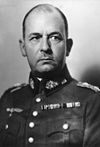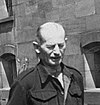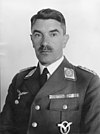12th Army (Wehrmacht)
| 12. Armee 12th Army | |
|---|---|
| Active | October 13, 1939 – 1943; 1945 |
| Country | |
| Branch | Army |
| Engagements | World War II |
The 12th Army (German: 12. Armee) was a World War II field army of the Wehrmacht.
History[]
The 12th Army was activated on October 13, 1939, with General Wilhelm List in command.[1] First seeing defensive action along the Siegfried Line, the army was involved in the invasion and occupation of France. The army was then relocated to Romania as part of the Axis offensive in the Balkans.
In February 1941, an agreement between Field Marshal List and the Bulgarian General Staff allowed the passage of German troops. On the night of February 28, German Army units crossed the Danube from Romania and took up strategic positions in Bulgaria.
On 6 April, units of the 12th army advanced into Yugoslavia and Greece. The Yugoslavians crumbled first. But, after six months of fighting the Italians, the Greeks could not stand up to the 12th Army's fifteen divisions, four of which were armored.
The British subsequently rushed four divisions from Libya to aid the Greeks but they, like the Greeks, were overwhelmed by the German panzers and by Luftwaffe strikes. The northern Greek armies surrendered to the Germans on April 23. Four days later German tanks entered Athens and hoisted the swastika over the Acropolis.[2]
The 12th Army became Army Group E (Heeresgruppe E) on January 1, 1943.
The 12th Army was reconstituted on the Western Front near the Elbe River on April 10, 1945.[3] Under General Walther Wenck, the 12th Army made the last attempt by a German Army to relieve German Führer Adolf Hitler in the besieged German capital during the Battle of Berlin. Although it successfully reached Potsdam, the 12th Army was stopped by numerically superior Soviet Red Army forces and forced to abandon the effort to relieve Berlin. The 12th Army then linked up with the remnants of General Theodor Busse's decimated 9th Army south of Beelitz and, in the confusion of the Soviet breakthrough, provided a corridor to the west for soldiers and refugees alike to reach and cross the partially destroyed Elbe River bridge at Tangermünde and surrender to American forces between May 4 and May 7, 1945.
Commanders[]
| No. | Portrait | Commander | Took office | Left office | Time in office |
|---|---|---|---|---|---|
| 1 | Generaloberst Wilhelm List (1880–1971) | 13 October 1939 | 29 October 1941 | 2 years, 16 days | |
| 2 | General der Pioniere Walter Kuntze (1883–1960) | 29 October 1941 | 2 July 1942 | 246 days | |
| 3 | Generaloberst Alexander Löhr (1885–1947) | 3 July 1942 | 31 December 1942 | 181 days | |
| 4 | General der Panzertruppe Walther Wenck (1900–1982) | 10 April 1945 | 7 May 1945 | 27 days |
See also[]
- 12th Army (German Empire) for the equivalent formation in World War I
- Invasion of Yugoslavia
- Battle of Greece
- Battle of Berlin
References[]
- ^ "12.Armee-Oberkommando". Feldgrau.com. Retrieved 3 January 2018.
- ^ Shirer, William L. (1950,1962), The Rise and Fall of the Third Reich: A History of Nazi Germany, pages 1079-1083, 34th Printing, published by Ballantine Books ISBN 0-449-21977-1
- ^ World War II Data Book, J. Ellis, 1993 Aurum Press, P 94. ISBN 1854102540
- Field armies of Germany in World War II
- Military units and formations established in 1939
- Military units and formations disestablished in 1943
- Military units and formations established in 1945
- Military units and formations disestablished in 1945



